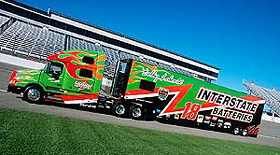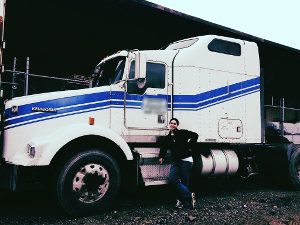(Driving Question) What Would You Do If...?
Topic 16906 | Page 1
Hmm...I don't know the right answer, but I think in that situation I'd probably come to a complete stop until I had some following distance, then proceed slowly using engine braking, then repeat if I caught up to traffic (probably making anyone behind me mad). But maybe you could use brakes in that situation since they probably wouldn't overheat when going slow, I don't know, but I wouldn't want to find that out the hard way. :)
OWI:
Operating While Intoxicated
The engine retarder should keep you at a constant rate, called the control speed. If the truck tends to speed up a bit, either control that with the brake, or bump the retarder up a notch.
Most of the time, "heavy traffic" will be moving more or less at a constant speed, so if you can match traffic speed to the control speed, you'll easily make it down the hill.
What will you do if you're driving a truck, going on a long or steep downgrade, in bumper to bumper traffic? Going off of the question on the practice test: On a long or steep downgrade, how should vehicle speed be primarily controlled? Through the braking effect of the engine. Will that still work as good in slow bumper to bumper or will that be a case where you need to use the air breaks?
I left the title a little vague so if I have more driving questions I can reuse this thread rather than making a new one each time.
Seems like two different questions. The difference is your following distance. Using just the engine/jake, you have to be hyper-alert for other drivers moving in front of you. You need to have your foot ready to brake all the time.
First is, "How to descend a long steep downgrade?" I use the engine as much as possible. I always felt a bit of pride when I could safely get to the bottom of a hill without needing to use the service brakes. By using the engine and controlling speed at the top of the hill it isn't that difficult. Donner, Cabbage, Siskiyous; just be patient and let the machine do the work.
Second is, "How to descend a long, steep downgrade in bumper to bumper traffic?" This describes every weekend coming into Denver from the West. There really isn't any way to avoid the service brakes. The engine won't bring you to a dead stop. You need to pick a gear that moves along with the flow of the Subarus, or have an automatic.
Remember, you can only go too fast once. If you try to keep pace with every other truck on the road, you'll get into trouble.
OWI:
Operating While Intoxicated

What will you do if you're driving a truck, going on a long or steep downgrade, in bumper to bumper traffic? Going off of the question on the practice test: On a long or steep downgrade, how should vehicle speed be primarily controlled? Through the braking effect of the engine. Will that still work as good in slow bumper to bumper or will that be a case where you need to use the air breaks?
I left the title a little vague so if I have more driving questions I can reuse this thread rather than making a new one each time.
Seems like two different questions. The difference is your following distance. Using just the engine/jake, you have to be hyper-alert for other drivers moving in front of you. You need to have your foot ready to brake all the time.
First is, "How to descend a long steep downgrade?" I use the engine as much as possible. I always felt a bit of pride when I could safely get to the bottom of a hill without needing to use the service brakes. By using the engine and controlling speed at the top of the hill it isn't that difficult. Donner, Cabbage, Siskiyous; just be patient and let the machine do the work.
Second is, "How to descend a long, steep downgrade in bumper to bumper traffic?" This describes every weekend coming into Denver from the West. There really isn't any way to avoid the service brakes. The engine won't bring you to a dead stop. You need to pick a gear that moves along with the flow of the Subarus, or have an automatic.
Remember, you can only go too fast once. If you try to keep pace with every other truck on the road, you'll get into trouble.
I was wondering about that too, how do you shift into a lower gear in an automatic? That likely is a really stupid question but I've never had to do that in a car (and yes I know cars and semi's are different).
OWI:
Operating While Intoxicated

In the automatic Pete I had, there was a pale switch on the side of the shifter that allows you to shift the gears up or down manually. You could put out in manual mode and just shift that way, or in auto mode of you downshifted manually it would stay in that hear until you hit the accelerator.
Light was wondering:
I was wondering about that too, how do you shift into a lower gear in an automatic? That likely is a really stupid question but I've never had to do that in a car (and yes I know cars and semi's are different).
In Freightliners the shift paddle will change gears in both auto and manual modes. Push it down for a lower gear.

If your thinking about bumper to bumper traffic as I think you are (stop and go traffic or snail speed traffic <5mph) you more than likely won't even be able to use an engine retarder (aka jakebrake) even on a fairly steep grade. Most trucks jakes will shut off under a certain rpm and some do not activate in your lower gears. Older trucks will but if they aren't shut off before the rpms drop to low it is not good for the engine and it can stall the engine.
Typically in the scenario I am imagining in your question you won't have to worry about jaking, what you'll really need to worry about are your knees and leg muscles because there is going to be a lot of clutch work! Let the vehicle in front of you gain some distance, how to take off on hills up or down you will learn later. I wouldn't bother shifting I would just let the vehicle crawl, controlling speed with service (foot) brake as needed. And stop again. rinse repeat. This is still primarily relying on the engine stopping power of the truck (no jakes). Picking the correct gear to be in is the first thing to do, can you use jakes or are they are prohibited for the area you are in needs to be considered. Know the truck you are in, what gears do the jakes work in, what rpm do they kick out. I would never assume that my jakes are going to work, they can malfunction (rare but true). It's like this, in any vehicle when you get off the accelerator, whether you brake or not they slow down. This is what engine stopping power is.
This is reminding me of rotor milling. It's like being stuck in stop and go traffic, except it's just you and the grinder. Uphill/downhill they do both (uphill is worst). All I know is at the end of the day my clutch leg hates me.

Revision: if you are in traffic that is moving fairly constant but is still snail speed, of course leave room for "oh ****" situations, but if jakes are allowed and the truck you are in you can use the jakes in the lower gears you can just be in probably 2nd gear and play with the jakes on and off to control speed. Saying this now I'm thinking of our KW T800s. Jakes only activate if you press the brake pedal. Which is convenient in some cases but in a case like this would not be. Ofc this goes under, know your truck.There are going to be a lot of situations that you won't really learn until they happen. Like most jobs, school and training prepares you but it can't teach you everything.

If your thinking about bumper to bumper traffic as I think you are (stop and go traffic or snail speed traffic <5mph) you more than likely won't even be able to use an engine retarder (aka jakebrake) even on a fairly steep grade. Most trucks jakes will shut off under a certain rpm and some do not activate in your lower gears. Older trucks will but if they aren't shut off before the rpms drop to low it is not good for the engine and it can stall the engine.
Typically in the scenario I am imagining in your question you won't have to worry about jaking, what you'll really need to worry about are your knees and leg muscles because there is going to be a lot of clutch work! Let the vehicle in front of you gain some distance, how to take off on hills up or down you will learn later. I wouldn't bother shifting I would just let the vehicle crawl, controlling speed with service (foot) brake as needed. And stop again. rinse repeat. This is still primarily relying on the engine stopping power of the truck (no jakes). Picking the correct gear to be in is the first thing to do, can you use jakes or are they are prohibited for the area you are in needs to be considered. Know the truck you are in, what gears do the jakes work in, what rpm do they kick out. I would never assume that my jakes are going to work, they can malfunction (rare but true). It's like this, in any vehicle when you get off the accelerator, whether you brake or not they slow down. This is what engine stopping power is.
This is reminding me of rotor milling. It's like being stuck in stop and go traffic, except it's just you and the grinder. Uphill/downhill they do both (uphill is worst). All I know is at the end of the day my clutch leg hates me.
Alright that's what I was thinking the slow 5mph mixed with stop and go traffic. I grew up in the Southern Cali high desert and I remember the Cajon Pass. A lot of times on that pass you'll see stop and go traffic going up hill and down hill and unless they have improved it since I moved even when traffic was free flowing it was never what I would call a fun drive and it wouldn't be uncommon to see over heated cars every few miles going up that hill. I haven't driven a truck yet today I'll hopefully be getting my learns permit so I know what the Jake break is but I haven't used one yet so hopefully by the time I need it I'll know how to use it and use it right.
OWI:
Operating While Intoxicated
New Reply:
New! Check out our help videos for a better understanding of our forum features

















Preview:








 TT On Facebook
TT On Facebook
What will you do if you're driving a truck, going on a long or steep downgrade, in bumper to bumper traffic? Going off of the question on the practice test: On a long or steep downgrade, how should vehicle speed be primarily controlled? Through the braking effect of the engine. Will that still work as good in slow bumper to bumper or will that be a case where you need to use the air breaks?
I left the title a little vague so if I have more driving questions I can reuse this thread rather than making a new one each time.